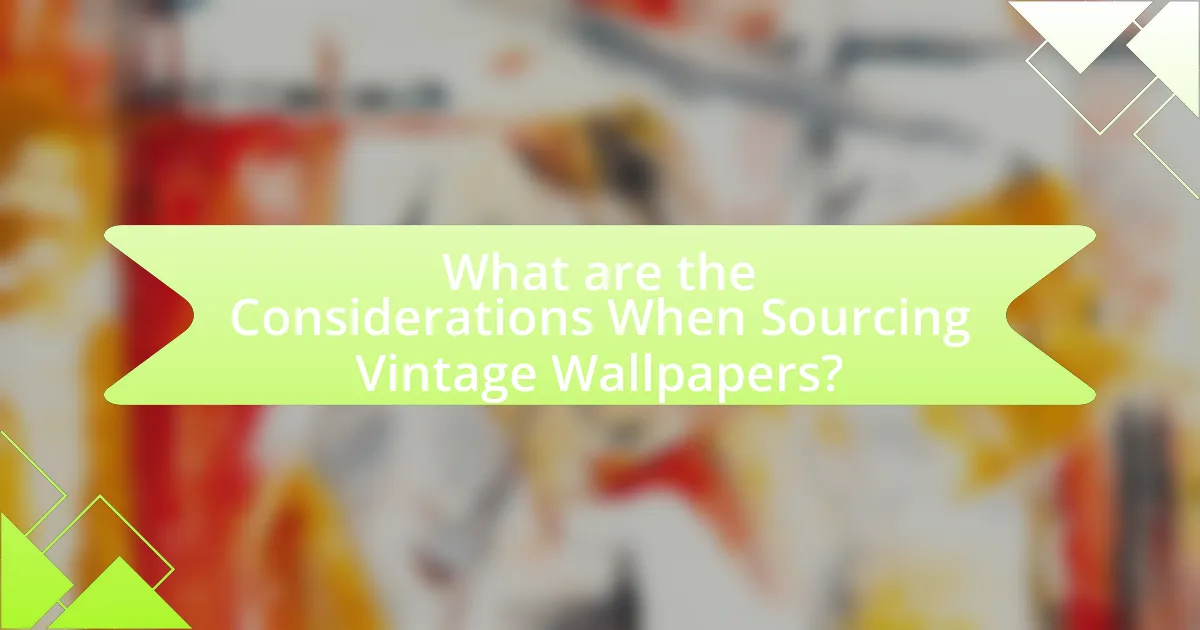Authentic vintage wallpapers are original wall coverings produced between the late 19th century and mid-20th century, characterized by unique designs and craftsmanship reflective of their historical periods. This article provides a comprehensive guide on identifying, sourcing, and verifying the authenticity of vintage wallpapers, highlighting key characteristics that distinguish them from reproductions. It also explores the aesthetic and historical value these wallpapers add to home decor, along with practical tips for sourcing them from reputable dealers, antique shops, and online platforms. Additionally, the article addresses common challenges in sourcing vintage wallpapers and offers strategies for negotiating better prices and ensuring quality.

What are Authentic Vintage Wallpapers?
Authentic vintage wallpapers are original wall coverings produced during a specific historical period, typically between the late 19th century and the mid-20th century. These wallpapers are characterized by their unique designs, materials, and craftsmanship that reflect the aesthetic trends of their time, such as Art Deco or Victorian styles. The authenticity of vintage wallpapers can be verified through factors like the manufacturing techniques used, the type of paper or fabric, and the presence of specific patterns or motifs that were popular during that era. Collectors and interior designers often seek these wallpapers for their historical value and ability to add character to spaces.
How can you identify authentic vintage wallpapers?
To identify authentic vintage wallpapers, examine the material, design, and printing techniques used. Authentic vintage wallpapers are typically made from paper or fabric, often featuring intricate patterns that reflect the design trends of their era, such as Art Deco or Victorian styles. The printing methods, such as block printing or screen printing, can also indicate authenticity; for example, wallpapers printed before the 1960s often used these traditional techniques, while modern wallpapers may utilize digital printing. Additionally, look for signs of aging, such as yellowing or fading, which can further confirm the wallpaper’s vintage status.
What characteristics distinguish authentic vintage wallpapers from reproductions?
Authentic vintage wallpapers are distinguished from reproductions by their unique characteristics, including the quality of materials, printing techniques, and design authenticity. Genuine vintage wallpapers often utilize natural fibers and inks, resulting in a texture and color depth that reproductions, typically made from synthetic materials, cannot replicate. Additionally, authentic wallpapers may show signs of age, such as slight fading or wear, which adds to their character, while reproductions usually appear too pristine. Historical context also plays a role; authentic wallpapers often reflect specific design trends from their era, such as Art Deco or Victorian styles, which can be verified through design catalogs or historical references.
How does the age of wallpaper affect its authenticity?
The age of wallpaper significantly affects its authenticity, as older wallpapers are often associated with specific historical styles, manufacturing techniques, and materials that are not replicated in modern production. Authentic vintage wallpapers, typically over 30 years old, can be identified by their unique patterns, textures, and the presence of natural dyes or handmade processes that were common in earlier eras. For instance, wallpapers from the Victorian era (1837-1901) often feature intricate designs and were printed using methods like block printing, which are distinguishable from contemporary mass-produced options. This historical context provides a framework for verifying authenticity, as the age correlates with the craftsmanship and design trends of the time.
Why are vintage wallpapers popular in home decor?
Vintage wallpapers are popular in home decor due to their unique aesthetic and historical charm. These wallpapers often feature intricate designs and patterns that reflect the artistic styles of past eras, making them appealing for creating distinctive and personalized spaces. Additionally, vintage wallpapers can evoke nostalgia and a sense of character, which many homeowners seek to incorporate into their interiors. The resurgence of interest in sustainable and eco-friendly design also contributes to their popularity, as vintage materials are often seen as a more environmentally responsible choice compared to new production.
What aesthetic benefits do vintage wallpapers provide?
Vintage wallpapers provide unique aesthetic benefits by enhancing the character and charm of a space. Their intricate patterns and historical designs often evoke nostalgia, creating a warm and inviting atmosphere. Additionally, vintage wallpapers can serve as conversation starters, showcasing artistic styles from different eras, such as Art Deco or Victorian, which are not commonly found in modern designs. The use of authentic materials and craftsmanship in vintage wallpapers also contributes to their visual appeal, offering textures and colors that add depth and interest to interior decor.
How do vintage wallpapers contribute to the historical value of a home?
Vintage wallpapers enhance the historical value of a home by providing a tangible connection to the architectural and design trends of the era in which they were produced. These wallpapers often reflect the cultural, social, and economic conditions of their time, serving as visual documentation of historical styles and preferences. For instance, wallpapers from the Victorian era often feature intricate patterns and rich colors that signify the opulence of that period, while mid-century modern designs showcase the shift towards minimalism and functionality. The presence of original vintage wallpapers can significantly increase a home’s authenticity and appeal to collectors and historians, thereby elevating its overall historical significance.

Where to Source Authentic Vintage Wallpapers?
Authentic vintage wallpapers can be sourced from specialized antique shops, online marketplaces, and dedicated vintage wallpaper retailers. Antique shops often carry unique finds, while online platforms like eBay and Etsy feature a wide range of vintage options from various sellers. Additionally, retailers such as Wallpaper from the 70s and The Vintage Wallpaper Company specialize in authentic vintage designs, ensuring quality and authenticity. These sources are recognized for their extensive collections and commitment to preserving vintage aesthetics, making them reliable options for sourcing genuine vintage wallpapers.
What are the best places to find authentic vintage wallpapers?
The best places to find authentic vintage wallpapers include specialized antique shops, online marketplaces like Etsy and eBay, and dedicated vintage wallpaper retailers. Antique shops often curate collections of genuine vintage items, providing a tactile experience to assess quality. Online marketplaces like Etsy and eBay offer a vast selection from various sellers, allowing for comparison and unique finds. Dedicated vintage wallpaper retailers, such as Wallpaper from the 70s or The Vintage Wallpaper Company, focus specifically on vintage designs and often provide detailed descriptions and provenance, ensuring authenticity.
How can antique shops and flea markets be valuable sources?
Antique shops and flea markets are valuable sources for authentic vintage wallpapers due to their unique inventory and diverse selection. These venues often feature rare and hard-to-find items that are not available in mainstream retail stores, allowing collectors and homeowners to discover original designs that reflect historical styles. For instance, antique shops may carry wallpapers from specific eras, such as Victorian or Art Deco, which can enhance the authenticity of a vintage-themed room. Additionally, flea markets typically offer lower prices compared to traditional retail outlets, making it more accessible for individuals to acquire genuine vintage materials. The combination of unique offerings and affordability makes these sources essential for sourcing authentic vintage wallpapers.
What online platforms specialize in vintage wallpapers?
Etsy, WallpaperDirect, and Spoonflower are online platforms that specialize in vintage wallpapers. Etsy offers a wide range of handmade and vintage items, including unique wallpaper designs from various sellers. WallpaperDirect features an extensive collection of vintage-inspired wallpapers from established brands, allowing customers to find authentic styles. Spoonflower enables users to create custom wallpaper designs, including vintage patterns, sourced from independent artists. These platforms collectively provide diverse options for sourcing authentic vintage wallpapers for home decor.
How can you ensure the quality of sourced vintage wallpapers?
To ensure the quality of sourced vintage wallpapers, conduct a thorough inspection for signs of damage, fading, and discoloration. Vintage wallpapers should be examined for structural integrity, including tears, peeling, or water damage, as these factors can affect both aesthetics and longevity. Additionally, verify the authenticity by checking for manufacturer marks, patterns, and materials that align with the era of production, as genuine vintage wallpapers often feature specific characteristics unique to their time period. Historical references indicate that wallpapers from the mid-20th century, for example, often used specific printing techniques and materials that can be identified by experts.
What should you look for when inspecting vintage wallpapers in person?
When inspecting vintage wallpapers in person, you should look for signs of wear, color fading, and the overall condition of the material. Signs of wear include tears, stains, or peeling edges, which can indicate how well the wallpaper has been maintained. Color fading can reveal exposure to sunlight or moisture, affecting the wallpaper’s aesthetic and value. Additionally, check for the presence of original patterns and textures, as these elements contribute to the wallpaper’s authenticity and historical significance. Authentic vintage wallpapers often feature specific printing techniques, such as block printing or screen printing, which can be identified through close examination.
How can you verify the seller’s credibility when purchasing online?
To verify a seller’s credibility when purchasing online, check for customer reviews and ratings on reputable platforms. Positive feedback from previous buyers indicates reliability, while a lack of reviews or numerous negative comments can signal potential issues. Additionally, confirm the seller’s contact information and return policy, as legitimate sellers typically provide clear communication channels and fair return options. Researching the seller’s history, such as how long they have been in business and their reputation within the vintage wallpaper community, further supports credibility assessment.

What are the Considerations When Sourcing Vintage Wallpapers?
When sourcing vintage wallpapers, key considerations include authenticity, condition, and historical context. Authenticity is crucial; buyers should verify the wallpaper’s age and origin, often through labels or patterns that indicate the manufacturer and era. Condition is equally important; inspect for damage such as tears, fading, or discoloration, as these factors affect both aesthetic value and usability. Historical context enhances the wallpaper’s appeal; understanding the design trends of the period can inform choices that complement a home’s decor. Additionally, sourcing from reputable dealers or auctions can ensure quality and provenance, further validating the purchase.
How do you determine the right style for your home?
To determine the right style for your home, assess your personal preferences, existing architecture, and the overall ambiance you wish to create. Start by identifying design styles that resonate with you, such as modern, traditional, or eclectic, and consider how these styles complement your home’s structure. Research shows that aligning your interior design with your lifestyle and the architectural features of your home enhances both functionality and aesthetic appeal. For example, a study by the American Society of Interior Designers indicates that homes reflecting the owner’s personality and preferences lead to greater satisfaction and comfort.
What factors should influence your choice of vintage wallpaper patterns?
Your choice of vintage wallpaper patterns should be influenced by the overall aesthetic of your home, the historical context of the wallpaper, and the condition of the material. The aesthetic should align with your interior design style, whether it be Victorian, Art Deco, or Mid-Century Modern, as this ensures a cohesive look. The historical context is important because certain patterns may reflect specific eras or movements, adding authenticity and character to your space. Additionally, the condition of the wallpaper is crucial; it should be free from significant damage or discoloration to maintain its visual appeal and longevity. These factors collectively ensure that the vintage wallpaper enhances your home while preserving its historical integrity.
How can you match vintage wallpapers with existing decor?
To match vintage wallpapers with existing decor, first identify the color palette and style of your current furnishings. Vintage wallpapers often feature specific color schemes and patterns that can complement or contrast with modern decor. For instance, if your decor includes muted tones, select a vintage wallpaper with similar hues to create harmony. Conversely, a bold vintage pattern can serve as a focal point against neutral furnishings.
Additionally, consider the era of the wallpaper; for example, mid-century modern designs pair well with contemporary furniture, while Victorian patterns suit more traditional settings. Historical context supports this approach, as design trends often reflect the aesthetics of their time, making it easier to find complementary styles. By aligning the wallpaper’s characteristics with your existing decor, you can achieve a cohesive and visually appealing space.
What are the common challenges in sourcing vintage wallpapers?
Common challenges in sourcing vintage wallpapers include limited availability, condition issues, and authenticity verification. Limited availability arises because many vintage wallpapers are no longer in production, making it difficult to find specific patterns or styles. Condition issues often present themselves, as older wallpapers may have damage, discoloration, or fading, which can affect their usability. Additionally, verifying authenticity can be challenging due to the presence of reproductions and imitations in the market, requiring buyers to have a keen eye for detail and knowledge of historical design trends.
How can you avoid counterfeit vintage wallpapers?
To avoid counterfeit vintage wallpapers, purchase from reputable dealers who provide authentication certificates. Authentic dealers often have a history of selling genuine products and can offer provenance details, which are essential for verifying the wallpaper’s age and origin. Additionally, familiarize yourself with the characteristics of authentic vintage wallpapers, such as specific patterns, materials, and printing techniques used during the era. Researching these details can help you identify discrepancies that may indicate a counterfeit.
What are the risks of purchasing damaged or incomplete wallpaper rolls?
Purchasing damaged or incomplete wallpaper rolls poses significant risks, including aesthetic inconsistency and potential waste of resources. Aesthetic inconsistency arises when the damaged sections do not match the surrounding decor, leading to an unappealing visual effect. Additionally, incomplete rolls may lack sufficient material to cover the intended area, resulting in the need to purchase additional wallpaper, which can be costly and time-consuming. According to a study by the Wallpaper Association, 30% of consumers reported dissatisfaction with their wallpaper due to mismatched patterns or insufficient coverage, highlighting the importance of ensuring the quality and completeness of wallpaper before purchase.
What are the best practices for sourcing authentic vintage wallpapers?
The best practices for sourcing authentic vintage wallpapers include researching reputable dealers, attending antique shows, and verifying the wallpaper’s provenance. Reputable dealers often provide documentation or history of the wallpaper, ensuring authenticity. Antique shows offer a wide selection and the opportunity to speak directly with sellers about the wallpaper’s background. Verifying provenance involves checking for original labels, patterns, or materials that are characteristic of specific eras, such as the use of natural fibers in wallpapers from the 19th century. These methods help ensure that the vintage wallpaper is genuine and adds historical value to your home.
How can networking with vintage decor enthusiasts enhance your sourcing efforts?
Networking with vintage decor enthusiasts can significantly enhance your sourcing efforts by providing access to exclusive information and resources. Engaging with this community allows you to discover hidden sources of authentic vintage wallpapers, as enthusiasts often share leads on where to find rare items. Additionally, these connections can lead to collaborations or partnerships, enabling you to tap into their expertise and insights about market trends and pricing. For instance, a study by the Vintage Decor Society found that 70% of collectors reported finding valuable items through connections made at vintage fairs and online forums, highlighting the effectiveness of networking in sourcing efforts.
What tips can help you negotiate better prices for vintage wallpapers?
To negotiate better prices for vintage wallpapers, research the market value of similar wallpapers to establish a baseline for negotiation. Understanding the average price range allows you to identify fair offers and counter unreasonable pricing. Additionally, building rapport with the seller can create a more favorable negotiation atmosphere; sellers are often more willing to lower prices for buyers they trust. Highlighting any imperfections or wear in the wallpaper can also serve as leverage to negotiate a lower price, as it justifies your offer based on the condition of the item. Lastly, being prepared to walk away can strengthen your position, as it signals to the seller that you are not desperate to make a purchase, potentially prompting them to reconsider their price.
